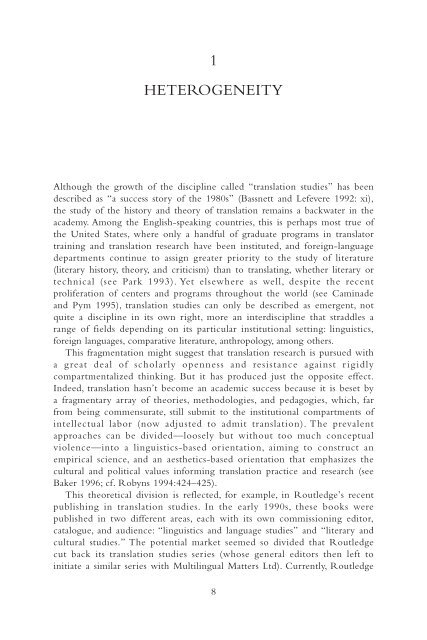THE SCANDALS OF TRANSLATION
9781134740642_sample_893345
9781134740642_sample_893345
You also want an ePaper? Increase the reach of your titles
YUMPU automatically turns print PDFs into web optimized ePapers that Google loves.
1HETEROGENEITYAlthough the growth of the discipline called “translation studies” has beendescribed as “a success story of the 1980s” (Bassnett and Lefevere 1992: xi),the study of the history and theory of translation remains a backwater in theacademy. Among the English-speaking countries, this is perhaps most true ofthe United States, where only a handful of graduate programs in translatortraining and translation research have been instituted, and foreign-languagedepartments continue to assign greater priority to the study of literature(literary history, theory, and criticism) than to translating, whether literary ortechnical (see Park 1993). Yet elsewhere as well, despite the recentproliferation of centers and programs throughout the world (see Caminadeand Pym 1995), translation studies can only be described as emergent, notquite a discipline in its own right, more an interdiscipline that straddles arange of fields depending on its particular institutional setting: linguistics,foreign languages, comparative literature, anthropology, among others.This fragmentation might suggest that translation research is pursued witha great deal of scholarly openness and resistance against rigidlycompartmentalized thinking. But it has produced just the opposite effect.Indeed, translation hasn’t become an academic success because it is beset bya fragmentary array of theories, methodologies, and pedagogies, which, farfrom being commensurate, still submit to the institutional compartments ofintellectual labor (now adjusted to admit translation). The prevalentapproaches can be divided—loosely but without too much conceptualviolence—into a linguistics-based orientation, aiming to construct anempirical science, and an aesthetics-based orientation that emphasizes thecultural and political values informing translation practice and research (seeBaker 1996; cf. Robyns 1994:424–425).This theoretical division is reflected, for example, in Routledge’s recentpublishing in translation studies. In the early 1990s, these books werepublished in two different areas, each with its own commissioning editor,catalogue, and audience: “linguistics and language studies” and “literary andcultural studies.” The potential market seemed so divided that Routledgecut back its translation studies series (whose general editors then left toinitiate a similar series with Multilingual Matters Ltd). Currently, Routledge8


